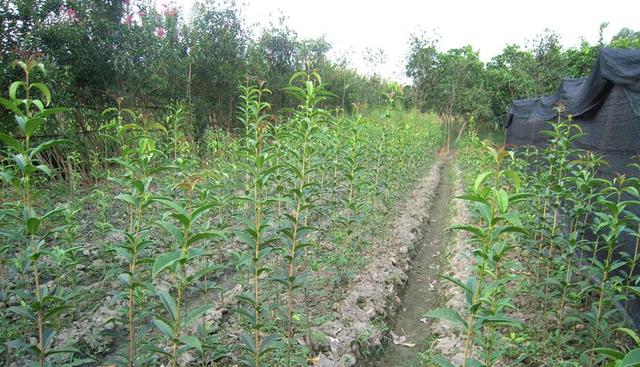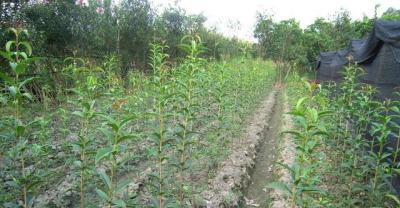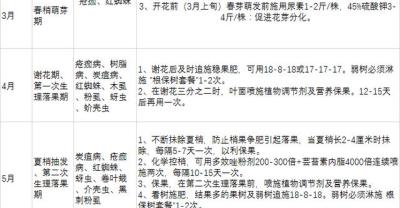Cutting Seedling and planting techniques of Cinnamomum frutescens
Cutting Seedling and planting techniques of Cinnamomum frutescens
Long-stalked osmanthus is a rare variety in Osmanthus fragrans population. It has good adaptability and resistance, and its tree shape is erect, capable and resolute. It is also known as "Golden Cinnamon" in the industry.
(1) strengthen the cultivation of seedlings and make a good source of varieties
There are many breeding methods of sweet-scented osmanthus, such as grafting, striping, cutting and so on. Because of its different varieties, the methods used are also different. The propagation method of Cinnamomum longiflorum is usually based on cutting, which has the advantage of simple propagation operation.
1.1 nursery site selection
The nursery should choose sandy loam or light loam with good drainage. If the soil is too sticky, it can be properly mixed with sand or perlite to adjust the soil texture, which can better prevent the occurrence of vertical blight and root rot, and spray pesticides on the seedbed before cutting to disinfect the soil. In order to ensure smooth drainage, the inserting bed should be slightly higher to prevent stagnant water after rain, resulting in ear rot, and waterlogging in the seedling bed during the rooting period of cuttings.
1.2 Shade shed for raising seedlings
Build a shade shed for closed seedling breeding. The height of the shade shed is 2m and the width of the slotting bed is 1.2m, but the two ends of the shade shed need to be ventilated, which can be opened and closed freely, so as to facilitate air circulation, reduce the temperature in the shade shed, and prevent direct sunlight.
1.3 ask when cutting
Combined with the local climate, the most suitable period is from late April to late May (autumn cuttings can be in early September to late October), when the degree of Lignification of cuttings is higher, the ground temperature increases gradually, and it is easy to take root and survive after cutting.
1.4 cuttage operation treatment
The young shoots that germinated in the same year should be used for cutting. Strengthen the fertilizer and water management of the mother tree of ear harvesting in winter to make the cuttings full and strong, apply compound fertilizer 2 or 3 times 40 days before ear harvest, balance water and fertilizer in spring drought, cultivate full and well-organized branches, promote new roots and improve the survival rate. The length of cuttings should be 8~10cm. After cutting, the cuttings should be placed in a cool and ventilated place, the leaves should be kept moist by spraying water, and 2-3 leaves should be retained when refurbishing cuttings. Most of the long-stalked Chinese osmanthus cuttings took root on the nodes, but there were few roots in the internodes, so it was appropriate to leave 1-2 nodes in the soil, and it was easier to retain the node head at the end. Before cutting, the cuttings were soaked with 500mg/L naphthalene acetic acid (8s) and slightly spread out to promote the early rooting and rapid rooting of sweet-scented osmanthus.
1.5 Cuttage
The cuttings are cut into the soil with a length of 2 degrees, plant spacing 3~5cm, row spacing 6~10cm, leaves should not overlap each other, and water should be sprayed after cutting. After the new shoots were pulled out, the film at both ends of the shade canopy was opened, and the seedlings were refined for 7-10 days. The seedlings were sprayed 2-3 times a day. After the seedling height was 40~50cm, the seedlings could be transplanted with soil. The long-stalked cinnamon formed healing tissue at the end of the cuttings and a tumor-like process between the cortex and xylem. After being treated with naphthalene acetic acid for 7-10 days, it formed healing tissue and began to produce new roots.
2 pay attention to the main points of transplantation to ensure the growth after transplantation
The root system of long-stalked cinnamon is well developed, the slow seedling stage is short, and the best transplanting time is in spring. The transplant site should choose a warm, sunny place, it is best to transplant in cloudy days or when the sun is not exposed to the sun, and transplant with earthen balls to ensure the survival rate. After transplanting, wrap the trunk with grass rope or film to keep the tree moist until the tree survives. Because the skin of sweet-scented osmanthus is thin and water is easily lost through the epidermis, it is necessary to avoid strong light and dry and hot wind to reduce water evaporation and ensure water balance in the tree before new roots grow. After transplanting, the big seedlings set up supporting wood to fix the tree body to prevent the root from loosening. The row spacing of transplanted seedlings is about 25cm × 25cm. After transplanting, stable fertilizer, nitrogen fertilizer and potassium fertilizer should be applied 3-4 times a year to give sufficient water fertilizer nutrients to promote the healthy growth of sweet-scented osmanthus. The long-stalked cinnamon likes to be wet and afraid of stains, so it should be watered once after transplanting and replenished in time to ensure the survival of seedlings. But the stagnant water in the root soil can also cause rotten roots, fallen leaves, and long-term stagnant water root rot directly leads to plant death. Sweet-scented osmanthus trees are not resistant to waterlogging. After entering August, it is necessary to gradually control the water to facilitate overwintering, prevent freezing, and prevent the invasion of diseases and insect pests.
3 Scientific pruning
3.1 pruning
Long-stalked cinnamon has the advantages of fast growth, high branches, early molding, strong tillering ability and good tree type. its trunk is straight and smooth, the crown is tight, steady and straight, straight and capable, elegant, with the masculine beauty of "man". Main points of pruning structure: cultivate a strong trunk with obvious central axis. The trunk of long stalk cassia is a single branch, and the central leadership trunk is also single upward, with few bifurcations, and only branches when it is about 1.8m long. The pruning is primary and secondary, and the subordinate relationship of the branches is clearly umbrella-shaped. That is, the main branch is born on the middle trunk, the deputy main branch germinates from the main branch, and the backbone branches at all levels are analyzed. The number of backbone branches grows properly, distributes reasonably and staggered. The growth intensity of the main branches is the same, and the distribution is uniform, so that the big branches are few and fine, and the branchlets are many and dense.
3.2 removing sprouting and sprouting
In the early stage when new buds just sprouted or new shoots were not lignified, sprouting and sprouting began to save tree nutrients and promote the rapid and healthy development of retained branches. The focus of de-sprouting and sprouting is mainly on the root neck of young trees near the ground, which should be carried out many times a year, especially before the new shoots flourish, so as to prevent the emergence of clustered branches and overgrown branches, competing in parallel with the trunk and disturbing the original tree type. If the sprouting is not removed or sprouted in time, the sprouting should be removed completely from the base when pruning. Young sweet-scented osmanthus trees are mainly cut lightly to reduce the loss of branches and leaves as much as possible, by means of sprouting, de-sprouting, heart-picking and twisting, and less scissors are used.
(4) strengthen cultivation management and improve plant resistance.
During the planting period of sweet-scented osmanthus seedling nursery, it is necessary to apply fertilizer 3-4 times a year. Before sprouting in early spring, the plant could promote spring shoot growth by applying organic fertilizer 8kg such as rotten bean cake, pig manure and poultry manure. After the sweet-scented osmanthus blossoms in autumn, in order to restore the tree potential and supplement nutrition, mature organic fertilizer is applied in the tree plate from after flowering to before winter. In the meantime, according to the growth of sweet-scented osmanthus, rapidly available nitrogen fertilizer should be applied twice, combined with phosphorus and potassium fertilizer, so as to promote the trunk growth and crown expansion of sweet-scented osmanthus. In order to make the root system of seedlings developed and concentrated, it is easy to survive after transplanting, fertilizer must be applied where the root system can be absorbed, for example, fertilizer must be applied within 1m to 2m diameter of the tree plate, otherwise the root system will expand too much, which is not conducive to the excavation of soil balls, and the survival rate of seedling transplanting will also be affected. However, it should be avoided under the tree trunk, the root system should not be in direct contact with fertilizer, so as not to burn trees and affect fertilizer absorption. It is better to apply fertilizer with water or shallow ploughing mulch, and try not to dig the soil deeply, otherwise when digging the soil ball, it is easy to appear the phenomenon that the soil ball is loose or unable to carry the soil ball.

(5) strengthen disease prevention and control and reduce management cost
In the natural environment, there are few diseases and insect pests in sweet-scented osmanthus planted sporadically, but with the widespread use of organochlorine and organophosphorus pesticides for many years, the natural enemies of pests are killed by widespread pesticides, and mites, whiteflies and shell insects still occur in a small amount. In addition, with the large-scale circulation of seedlings in recent years, it is difficult to achieve a comprehensive quarantine of diseases and insect pests, resulting in the accelerated spread and cross-spread of some seedlings with diseases and insect pests, large-scale single-species seedling cultivation, building a piece of sweet-scented osmanthus forest, and so on. it also highlights the diseases and insect pests of sweet-scented osmanthus.
5.1 Prevention and control of main diseases dry rot
It mainly occurred on the newly transplanted sweet-scented osmanthus plants. Due to bruises during digging, scratches during long-distance transportation, strangulation during hanging, accidental injuries and other reasons, the bark of the trunk or branches of sweet-scented osmanthus was seriously damaged and failed to be properly protected in time, resulting in decay at the wound, xylem exposure or the formation of cancer tumor. cause poor plant growth, a large number of leaves fall off, big branches die, and in serious cases, the whole sweet-scented osmanthus will die. Prevention and treatment: clean up the wound locally and apply the wound healing agent in time to promote the wound healing as soon as possible. For the old large wound on the tree trunk, the exposed rotten xylem can be cleaned up, stone-sulfur mixture can be smeared on the anticorrosive wound regularly, and the rotting part of the thick sweet-scented osmanthus plant which has formed a cavity can be removed completely. pay attention to protect the undecayed xylem isolation layer and fill the cavity with polyurethane foaming agent.
5.2 main pest control
At present, sweet-scented osmanthus pests blow cotton scale, whitefly have a small number of occurrence.
5.2.1 blowing cotton scale. After hatching, the larvae disperse their activities, transfer from the tender shoots and the back of the leaves to the social harm on the branches, absorb the tree sap, and excrete honeydew, resulting in coal fouling disease. Due to the cross-harm of diseases, it often leads to yellowing leaves and wilting branches of sweet-scented osmanthus. Prevention and control methods: reduce the use of pesticides and protect natural enemies; find a small number of insects and wipe them out in time; spray 0.3 ~ 0.5 °be stone sulfur mixture in winter to kill overwintering pests; during the peak incubation period, spray with 2000 times of 15% buprofezin wettable powder, 1500 times of 40% dimethoate EC or 3000 times of 40% fast killing EC.
5.2.2 whitefly. It mainly uses the mouthparts of adults and larvae to pierce the mesophyll on the back of the leaves to absorb juice, which makes the leaves of sweet-scented osmanthus curl, fade green and yellow, and even dry up, and excrete a large amount of honeydew, cause coal pollution, seriously pollute the branches and leaves of sweet-scented osmanthus, and lead to poor growth of sweet-scented osmanthus, thus affecting the normal flowering and display of sweet-scented osmanthus. Control methods: protect natural enemies such as Bemisia Tabaci, Bemisia Tabaci and Bemisia Tabaci, and use yellow armyworm board to trap and kill adults. in order to improve the control effect and restrain the resistance of whitefly, attention should be paid to the principle of alternating and mixed use of pesticides. If you can use 1000 times of 10% paracetamol EC, 2000 times of 10% imidacloprid wettable powder, 1500 times of 40% omethoate EC, 2000 times of 25% permethrin wettable powder, or 2000 times of 20% permethrin, etc.
6 the prospect of popularization and application
Long-handle osmanthus is a combination of greening, beautification and fragrance, which is good in shape, color, rhyme and taste, so it is deeply loved by the Chinese people and is a rare variety of sweet-scented osmanthus. Its tree shape is tall and straight, capable, and the leaf color is thick green and soft. Long-stalked cinnamon begins to blossom in 5 years, blossoms 2-3 times a year after 7-8 years old, in September-October, and in April of the following year, the flowers are golden, the flowers are numerous, the flowers and leaves are fragrant and persistent, regardless of the size of the year. Long stalk Jingui has strong tillering ability, it only takes 2 years from the cuttage seedling to the total height of 2m, at the same time, the rice diameter can reach more than 1.2cm, and when the rice diameter reaches 4cm, the annual diameter can reach 2cm. Long-stalked cinnamon has well-developed root system, cold and drought resistance, strong disease resistance and stress resistance, strong ornamental and artistic ability, and is worth popularizing.
- Prev

When fruit trees are planted in rural areas, how long will it take to get an income?
How long does it take to grow fruit trees in rural areas? now there are fewer and fewer farmers, low income or other reasons, rural people basically breed or plant for a living, because they do not.
- Next

Sugarcane planting in Xiashan Qinghe Garden
Sugarcane planting in Xiashan Qinghe Garden
Related
- Fuxing push coffee new agricultural production and marketing class: lack of small-scale processing plants
- Jujube rice field leisure farm deep ploughing Yilan for five years to create a space for organic food and play
- Nongyu Farm-A trial of organic papaya for brave women with advanced technology
- Four points for attention in the prevention and control of diseases and insect pests of edible fungi
- How to add nutrient solution to Edible Fungi
- Is there any good way to control edible fungus mites?
- Open Inoculation Technology of Edible Fungi
- Is there any clever way to use fertilizer for edible fungus in winter?
- What agents are used to kill the pathogens of edible fungi in the mushroom shed?
- Rapid drying of Edible Fungi

